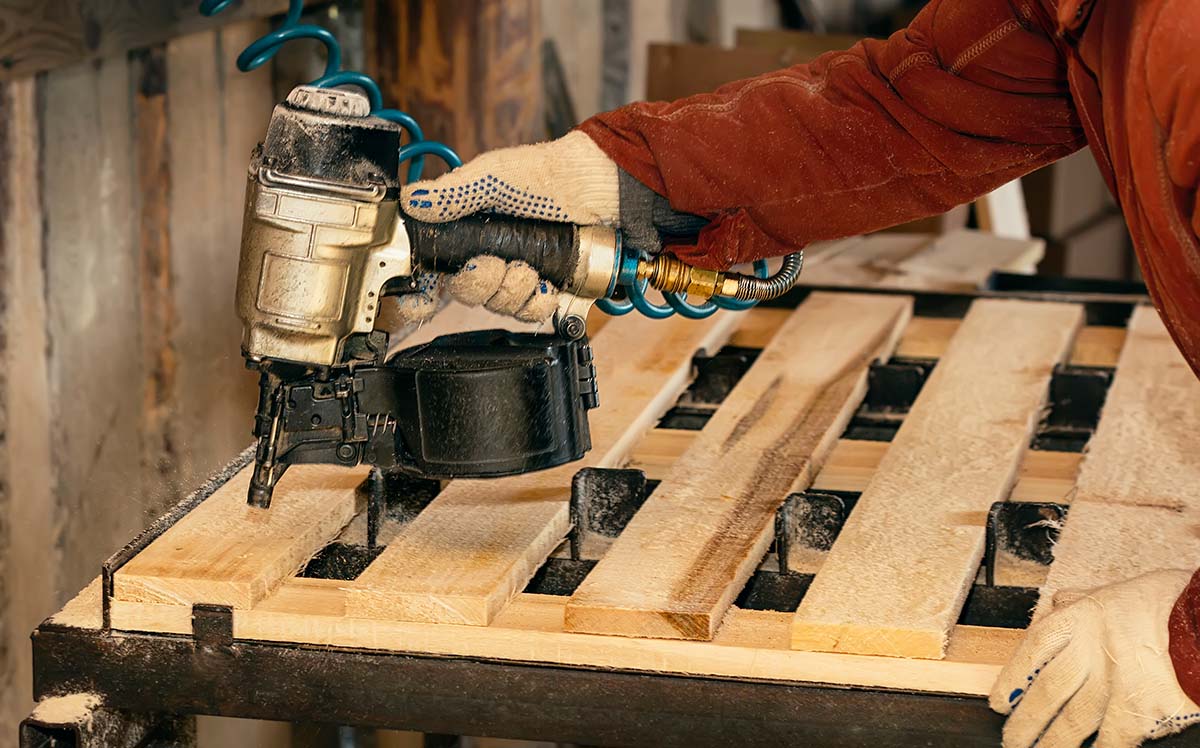Strong, sturdy, and reliable, pallet boards keep industries going across the globe. The wooden planks lay nailed, stapled, and screwed to pallets in warehouses, factories, and plants everywhere – but what are they?
Just taking a quick Google search for the question “What are pallet boards?” will pull up thousands of results from wood packaging companies, wholesalers, and DIYers alike. Curiously enough, you’ll have trouble finding a definition for this simple, common term.
For the most part, in your search, you’ll find options to buy new pallets, buy old pallets, or buy “reclaimed” pallet boards. Today (yes, today!) we’re going to offer three answers to the question, “What are pallet boards?”
We’ll break it down into three “palatable” sections including, pallet boards by definition, the cost-effectiveness of pallet boards, and the strength of pallet boards.
1. The Humble Pallet Board
Pallet boards, commonly known as deck boards to pallet manufacturers and industry professionals, are the wooden planks that are fastened to the top and bottom of pallets. In a broader sense, they could really refer to any of the boards used to construct pallets, such as stringers and notched stringers. Although this seems like a straightforward definition, the variety of pallet boards on the current market is astronomical.
Three main factors determine what exactly pallet boards are destined for, the number of combinations is actually quite amazing. Species, dimensions, and heat treatment, all factor into the use of the pallet board.
Pallet boards can be made from virtually any species of tree, but the most common species are Southern Yellow Pine (SYP), Spruce-Pine-Fir (SPF), and a variety of different hardwoods. Each of these species come with their own individual strengths and weaknesses – manufacturers determine which species to build from based on the exact use of the pallet.
This wood product comes in a variety of shapes and sizes determined by the product they’re meant to move. Dimensions on pallet boards, and their perspective lead boards, can be customized to any need. From industrial grade HVAC units to heavy industrial pipe and steel, pallet boards can be made to hold it all.
Lastly, heat treatment also increases the variety of pallet boards available. ISPM-15 heat treatment is applied to all wood destined for international shipping, pallet boards included. The heat treatment process ensures that wood packaging is devoid of wood parasites that could wreak havoc should it reach foreign shores.
As you now know, there’s quite a bit of intricacy when it comes to pallet boards. Although they may seem simple, this common item can come in a variety of different ways.
2. Pallet Boards – A Cost Effective Product
What are pallet boards? Well, they’re cost-effective.
Cost-effectiveness is determined by a myriad of variables, but it can really be simplified into two factors – availability of resources and manpower needed.
Let’s start with the availability of resources.
Although it may be evident, pallet boards are in fact made of wood or lumber. The lumber industry in North America is one of the continent’s oldest and most profitable industries, and for good reason. North American forests were, and still are, extremely vast. With continually improving resource management, these forests will continue to produce large amounts of useable lumber for years to come.
North American forests were, and still are, extremely vast. With continually improving resource management, these forests will continue to produce large amounts of useable lumber for years to come. Share on XAll of this being said, lumber is available everywhere for personal and commercial use. With a quick search, most people could find some ready-to-use within 10 miles. Lumber is an extremely available resource.
Next, up on our list is manpower needed.
Unlike many of the products you use on a day-to-day basis, not many hands have touched pallet boards before they get to the end-user. From timber companies, to sawmills and treaters, to manufacturers, only a few hands typically touch a pallet board before it’s in use on a pallet.
Compared to steel or plastics, pallet boards require less manpower than many manufactured goods we’re accustomed to.
Because of the availability of and the amount of manpower needed to produce pallet boards, they end up being a relatively inexpensive product without sacrificing quality.
3. They’re Stronger Than You Might Think
If pallet boards are anything, they’re strong. Manufacturers use industrial wood to make these wooden planks sturdy and reliable so that they can do their job moving different products. Depending on the pallet, pallets can be used to transport a few dozen pounds of product, to thousands of pounds of products.
If pallet boards are anything, they’re strong. Manufacturers use industrial wood to make pallet boards sturdy and reliable so that they can do their job moving different products. Share on XPallet boards face a lot of stress during their life. Stress on pallet boards can be seen in many different forms. Vertical stress from the weight of its payload, shifting weight from transportation, and stress from the bottom up from being picked up by forklifts can all cause problems for pallet boards.
With all this stress being put on them, sometimes the strength of pallet boards can fail as the pallet continues to be used. Luckily, some manufacturers sell pallet cut parts so that pallet recyclers and other businesses can replace damaged portions and make their pallets as strong as ever.
We Hope Those Were Palatable Answers!
Whether individually or a part of a pallet, pallet boards are something special. They literally hold up all the things they transport, they’re cost-effective, and they’re ridiculously strong. Between these three answers, we hope that we’ve sufficiently answered the question, “What are pallet boards?” once and for all.



![[PRESS RELEASE] Conner Industries Announces Major Guardian Packaging Expansion](https://conner.b-cdn.net/wp-content/uploads/2024/10/Guardian-Packaging-Expansion-500x383.jpg)
![[PRESS RELEASE] Conner Industries Announces Website Dedicated to Integrated Packaging Division](https://conner.b-cdn.net/wp-content/uploads/2024/05/Conner-Packaging-Blog-500x383.jpg)


